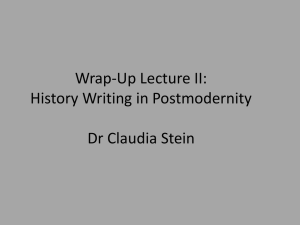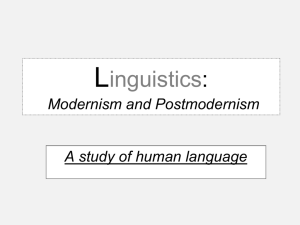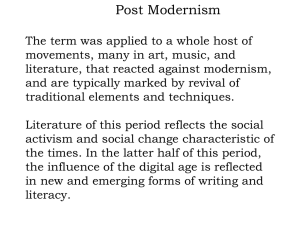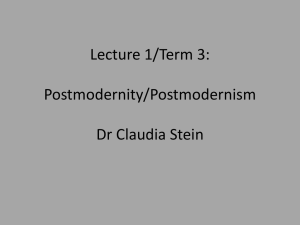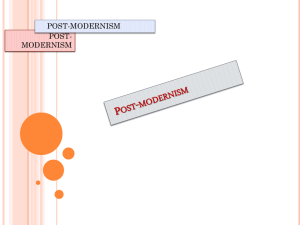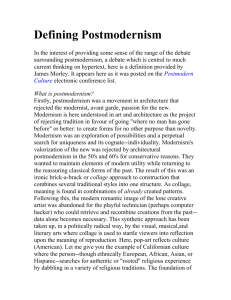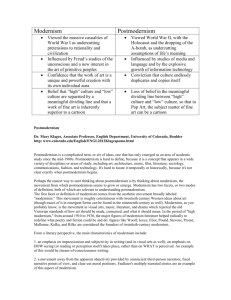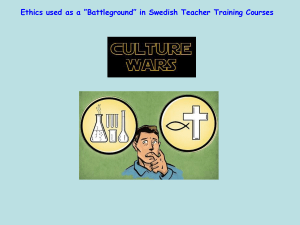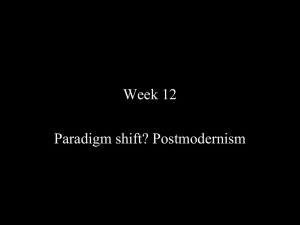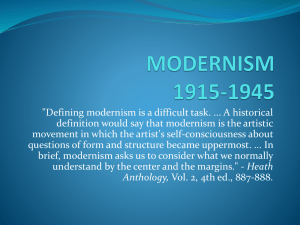MAKING OF THE MODERN WORLD: WEEK 23
advertisement
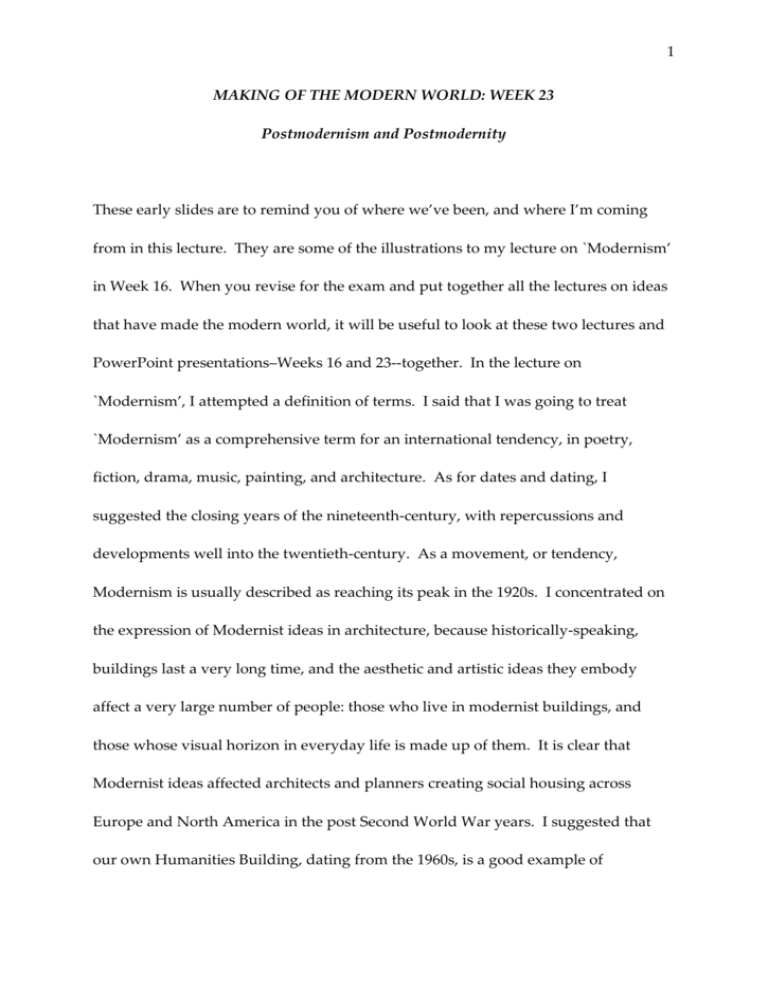
1 MAKING OF THE MODERN WORLD: WEEK 23 Postmodernism and Postmodernity These early slides are to remind you of where we’ve been, and where I’m coming from in this lecture. They are some of the illustrations to my lecture on `Modernism’ in Week 16. When you revise for the exam and put together all the lectures on ideas that have made the modern world, it will be useful to look at these two lectures and PowerPoint presentations–Weeks 16 and 23--together. In the lecture on `Modernism’, I attempted a definition of terms. I said that I was going to treat `Modernism’ as a comprehensive term for an international tendency, in poetry, fiction, drama, music, painting, and architecture. As for dates and dating, I suggested the closing years of the nineteenth-century, with repercussions and developments well into the twentieth-century. As a movement, or tendency, Modernism is usually described as reaching its peak in the 1920s. I concentrated on the expression of Modernist ideas in architecture, because historically-speaking, buildings last a very long time, and the aesthetic and artistic ideas they embody affect a very large number of people: those who live in modernist buildings, and those whose visual horizon in everyday life is made up of them. It is clear that Modernist ideas affected architects and planners creating social housing across Europe and North America in the post Second World War years. I suggested that our own Humanities Building, dating from the 1960s, is a good example of 2 Modernist ideas in action, which affect every single one of us here, ninety years after `Modernism’ is supposed to have reached its peak. That definition of terms gives me a good foundation for today’s definitions, at least as far as the `post’ and `modernism’ in my title are concerned. Postmodernism is what came after Modernism. Obviously! What I didn’t do, way back in Week 16, is attempt to distinguish between `modernism’ and `modernity’. I have to do that today, because the title I’m working to is `Postmodernism and Postmodernity’. So it will be useful to briefly talk about the difference between the two labels `Modernism’ and `modernity’. (I feel as if I’m writing a version of Raymond Williams’s Keywords! The point is that you can find these definitions and distinctions in dozens of dictionaries of term and glossaries of social thought.) `Modernism’ describes a set of artistic, aesthetic and theoretical ideas. `Modernity’ is the label given to the era in which those ideas were active in society and culture. By extension, `Postmodernism’ describes a body of ideas and theories (ideas about the world and human subjects); `Postmodernity’ was the period, or era, in which those ideas were active, and again, affected a large number of people. Again, in this lecture, I shall use architecture as my example of postmodernist ideas-in-action, for exactly the same reason as I used architecture as my example when discussing Modernism. Please note that I have just used the past tense. I have not talked to Dan Branch about tomorrow’s lecture on `Postcolonialism & the Provincializing of Europe’. But I believe that globalisation, and the rise of global history, has ended the 3 postmodern tendency in the arts, humanities and the social sciences. History written from the perspective of other societies, other cultures, other pasts, removes the West from the centre of the stage--the place from where history is written. I am suggesting throughout this lecture that `Postmodernism’ was a Western phenomenon. Moreover, it was a largely academic phenomenon: a body of idea that emerged in university departments and academic writing across the Western world. But of course, architecture puts paid that too-neat definition, for architecture is the way in which ideas get out onto the street, and into people’s lives. So let’s begin to explore `Postmodernism’ as an idea. Much of what you read on the postmodern turn suggests that it was underpinned by a turn to language as a tool for investigating and describing all sorts of phenomena, including the human past. The cultural critic Frederic Jameson, who has commented widely on postmodernism, says that it originated in a twentieth-century attempt `to think everything through again in terms of linguistics’. He said that in 1972, before postmodernism really had a name. But without a label, he could see changes taking shape in the world of ideas and theories. A central idea was that we could not know ... anything ... for certain. There was no absolute meaning, no true `truth’ that we could find, or determine. Meaning was and is, always indeterminate. Meaning, or truth, is not to be found in things themselves, but rather, in the relationship between things, and that relationship was itself, shifting and arbitrary. These are strange and abstract ideas, very difficult to get you head around until you understand the profound affect of linguistics on scholars of the mid-twentieth century. I’ll go back 4 to a figure I briefly flashed before you, in my lecture on the end of positivism. Very odd--to my mind at least--was the very great post-War influence of a quite ordinary linguist of the early twentieth century, Ferdinand de Saussure (1857-1913). Saussure died in 1913. But later, when his work came to be republished, translated and used, what he appeared to be insisting was that the only place to find meaning, is in difference. The book called Course in General Linguistics was put together out of his lecture notes for undergraduate students; it was published after his death, in 1916. It was to have very little effect until the1950s and 1960s, when the model of language it proposed was taken up by a number of scholars from different fields, and used to describe quite different phenomena from that of language. (Le Cours de Linguist Générale was translated into English for the first time in 1959.) So in the 1950s and 1960s, a system of ideas, evolved for the study of language half a century before, was taken and applied to the fields of sociology, anthropology, political science, philosophy, and later, to history. What had Saussure proposed to his lecture rooms of students in the years before the First World War? First, that language works according to its own, internal system of rules, and is not particularly connected to the external reality we think it describes. The idea works like this: Here on this slide are three marks: c - a - t : these marks make up a signifier which evokes the signified `cat' in the English mind. But the relationship between the signifier and the signified is entirely arbitrary. There is no essential reason why those three marks should mean cat. After all, if you were Spanish, the signifier would be g - a - t - o. The relationship between the whole 5 signifier and the furry thing that purrs is therefore arbitrary as well. Each sign in the system has meaning only because it is different from other signs: `pipe' does not mean anything in itself; it only means something because it is not `pope' or `pip' or `tripe' (and c-a-t only has meaning because `cat' is not `mat', `cap' or `cut' ...). `In the linguistic system there are only differences', said Saussure. Meaning does not reside in the word or sign, but is a function of its difference from other signs. A central idea of the post-modern turn is that we should be much more interested in the relationship between things, than in the things themselves. Meaning is relational. The meaning of things, of events, of actions, lies not in the things themselves, but in the relationships between them. Historians who have been interested, or who have used these ideas, are sometimes spoken of as having taken the linguistic turn. Such historians took seriously the implications of the linguistics just described. They understand (or understood) that many things--human minds, human societies, cultures--work like a language works: things only mean something because of their difference from other things. Historians who took this turn believed that we can read the past as if it were a text. By 1991, the sociologist Anthony Giddens was ready to write a text book about postmodernism, for sociology students and others. He said that `we have discovered that nothing can be known with any certainty’; that history is not a story of unimpeded progress towards the present; that it is impossible to defend any notion of progress ... . Is the `story’ of the Making of the Modern World–that you’ve been studying since last October—a story that you can’t really know with any certainty? You’ve 6 probably never thought that it was a story of unimpeded progress towards the present, and if you ever have, you’ve probably also asked `whose present?’; `whose progress?’ We are perhaps more aware of the highly specific nature of the Western historical endeavour than were sociologists and historians of the 1980s and 1990s; perhaps our awareness comes from these developments—postmodernism and postmodernity--of the mid-twentieth century. In your reading, you may find the developments described by Giddens labelled the `End of the Enlightenment Project’. That phrase seems a useful way of linking postmodernism and postmodernity to the whole of `Making of the Modern World’. MMW takes as its starting place the European Enlightenment, and the Age of (Atlantic) Revolutions. So what was the Enlightenment Project?—and is it over now? After the philosophic and religious revolutions of the seventeenth century, human beings rather than God came to be understood as the centre of the world. Eighteenth- and nineteenth-century thinkers created new knowledge, did new thinking, constructed new philosophies about Man, or human beings, rather than about God. After the world-changing political events of the later eighteenth century, liberty, equality, and freedom from oppression came to be accepted as the proper political aims of human societies. The public sphere extended as state expanded its arena of influence, in all Western societies. A combination of industrialisation and developments in state power brought the classes of modern society into existence. New technologies raised the hope that science and reason might be harnessed in order to improve, or even perfect, society. When twentieth-century thinkers and 7 historians talked about `the Enlightenment Project' they meant all of these changes, beginning in the late seventeenth century. And they talked about its end. Postmodernist thinkers claimed that the Enlightenment Project, the idea of the world as meaningful and purposeful, had been challenged by key events of the twentieth century. On the other side of the Iron Curtain, the spectre of Stalinism and of `actually existing socialism' made Enlightenment claims concerning the rationality of the state meaningless. `State power' had come to mean totalitarianism. The end result of the decolonisation process, experienced in the European metropole and in the newly named Third World, was not an experience of liberty and equality. Rather, the post-colonial era witnessed new forms of oppression coming into being. The European working-classes may have been emancipated, in that after long and weary struggles they were incorporated in the polity, and all Western societies established some form of welfare state, from about 1870 to 1950. But the emancipated worker looked very different from the working-class hero of the nineteenth-century political imagination, being more interested in a new car, DIY, transforming the back garden with decking and a holiday in Spain, than in political activism and civic life. Then, in various post-modernist accounts of this period, the whole Enlightenment Project was dealt a further blow, in a series of political shifts to the right: electoral victories for Margaret Thatcher in 1979 and Ronald Reagan in 1981. These, combined with the decline of the welfare states (especially in Britain), the decline in the traditional manufacturing bases of the West, and the shift of the 8 market, onwards and outwards, further East, further South, as global capitalism found new markets to conquer and new classes to make;--these, and the political immobility of the Western working class, provided a political context of defeated progressivism, in which the only response was the playful, ironic, self-conscious parodies of post-modernism. History had lost its point, its end and purpose. 1989 had seen the triumph of the West, the triumph of capitalism. History was - is - at and end. Narrative itself was over and gone: the telling of all stories that have logic and sequence, stories that explain something (explain something like historical ruptures of the late eighteenth century) were no longer an option. Those old nineteenth-century narratives had provided a culture of modernity. All the new `sciences' of the nineteenth-century—biology, history, anthropology, psychology—had been the attempts of numerous nineteenth-century thinkers to give meaning to the events. Darwin told the great evolutionary story; the novel attempted historical explanations of the stories it told; History itself--the discipline of History—was a nineteenthcentury development. All of them (the sciences, history, the social sciences) used narrative to tell a story of progression. Post-modernism, on the other hand, is not about development, progress, or the steady march of time. Back to dictionary definitions, and my illustrative slides. Remember that I am using architecture as an example of the way in which these ideas were understood and experienced. Postmodernism: a word for describing the overall direction of experimental tendencies in Western arts, especially in architecture, but also in the media, since the 1950s. In post-modern architecture, a range of styles and 9 techniques, a range of references and period details, are all brought together in one immensely referential statement. Postmodernist architecture is associated with a revolt against order and reason; a revolt against representation and narrative; it tends towards eclecticism, irony, parody, quotation and play. Uncertainty, eclecticism and parody were understood as the very basis of art. Just as an early modern oaste-house merges with the illustration from 1950s children’s books in the design of a Tesco store, forms merge in digital technology, on the net, and there are crossovers between high art and popular art. Start to use the useful word hybridization. Late twentieth-century philosophy interacted with these artistic movements. In the 1970s, post-modern philosophy attempted to demystify authority, whether it is the authority of language, the authority of rationality, or the authority of masculinity: to de-canonise and demote authority from being the takenfor-granted of the modern world. In conclusion, I think that I think that what we have here are several accounts and definitions of post-modernism and postmodernity. Post-modernism, as I have described it today, is a catchall concept. It describe a heterogeneous group of cultural trends, ways of thinking with the linguistic model, and social directions, of the second half of the twentieth century. You can analyse it by considering a number of social, economic, cultural and political histories, of the last fifty years in the West. And if I put to one side the meanings derived from art and architecture, and see those buildings that look like a pair of binoculars as a result, or expression-not a cause--of the tendencies I have been describing?—Then I think that I have been 10 talking about three main themes: I have been talking about a phase of development an economic and social system that goes by the name of capitalism. Second, I have discussed a culture of capitalism, that is, the ways in which human beings make and create meaning out of the material conditions of their existence. Taking this view, you might say that post-modernism is what people have made out of the condition of post-modernity. The postmodern and linguistic turns are certainly also part of a history of ideas: a social history of ideas, in which what people know (or believe they know) gets used and reformulated into a sense of identity or self: into what they believe they are. I think that this period and these developments are particularly rich in evidence for future historians, of ways in which people understood themselves as selves, as identities.
